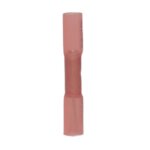Butt connectors are a popular choice for joining two wires together, offering a simple and effective solution for electrical connections. However, improper use of butt connectors can lead to poor connections, reduced performance, and even safety hazards. In this blog post, we'll discuss the ten most common mistakes people make when using butt connectors and how to avoid them.
1. Using the Wrong Size Butt Connector
One of the most frequent mistakes is using a butt connector that is too small or too large for the wires being joined. Using a connector that is too small can result in a loose connection, while using one that is too large can make it difficult to crimp properly. Always choose a butt connector that is sized appropriately for the wire gauge you are working with.
2. Failing to Strip the Wires Properly
Before inserting the wires into the butt connector, it is crucial to strip them to the correct length. Stripping too much insulation can leave exposed wire, while not stripping enough can result in a poor connection. Use a wire stripper to remove the insulation, ensuring that the stripped length matches the depth of the butt connector.
3. Not Twisting the Stranded Wires
When working with stranded wires, it is essential to twist the strands together before inserting them into the butt connector. Failing to do so can cause the strands to spread out, resulting in a weak connection. Twisting the strands ensures that they remain compact and make proper contact with the connector.
4. Crimping the Connector Incorrectly
Improper crimping is another common mistake that can lead to a faulty connection. Using the wrong crimping tool or applying insufficient pressure can result in a loose or incomplete crimp. Always use a crimping tool that is designed for the specific size and type of butt connector you are using, and apply firm, even pressure to ensure a secure connection.
5. Neglecting to Heat-Shrink the Connection
Heat-shrink tubing provides an extra layer of protection and insulation for the butt connector and the wires. Failing to use heat-shrink tubing can leave the connection vulnerable to moisture, dirt, and other environmental factors. Slide a piece of heat-shrink tubing over one of the wires before making the connection, and then slide it over the butt connector and apply heat to shrink it in place.
6. Using Butt Connectors in High-Vibration Environments
Butt connectors are not designed to withstand high levels of vibration, which can cause the connection to loosen over time. In applications where vibration is a concern, such as in vehicles or machinery, it is better to use alternative connection methods, like soldering or crimp terminals, that are more resistant to vibration.
7. Exposing Butt Connectors to Extreme Temperatures

Butt connectors have temperature ratings that specify the maximum and minimum temperatures they can withstand. Using butt connectors in environments that exceed these temperature limits can cause the plastic insulation to melt or become brittle, compromising the integrity of the connection. Always check the temperature rating of the butt connectors and ensure they are suitable for the application.
8. Not Insulating Multiple Connections
When making multiple connections in close proximity, it is crucial to insulate each connection individually. Failing to do so can lead to short circuits or electrical arcing between the connections. Use heat-shrink tubing or electrical tape to insulate each butt connector separately, ensuring that there is no exposed metal or risk of contact between the connections.
9. Reusing Butt Connectors
Butt connectors are designed for a single use and should not be reused. Attempting to reuse a butt connector can result in a poor connection, as the connector may have been deformed or damaged during the initial crimping process. Always use new butt connectors for each connection to ensure optimal performance and reliability.
10. Ignoring the Current Rating
Butt connectors have current ratings that specify the maximum amount of electrical current they can safely carry. Using a butt connector with a current rating lower than the application requires can lead to overheating and potential failure of the connection. Ensure that the butt connectors you select have a current rating that is appropriate for the electrical load of your application.
Also see: Nylon vs. Vinyl Butt Connectors for Wires: Is There a Major Difference?
Conclusion
Butt connectors are a convenient and reliable solution for joining wires, but it is essential to use them correctly to ensure a safe and secure connection. By avoiding these ten common mistakes, you can improve the quality and longevity of your electrical connections.
For more insights and tips on cable ties and other related products, be sure to explore cabletiesunlimited.com and follow us on our social media communities on Facebook and Instagram!
Want to speak with one of our professionals? Reach out at 866-891-0137 and we'll be delighted to help!

